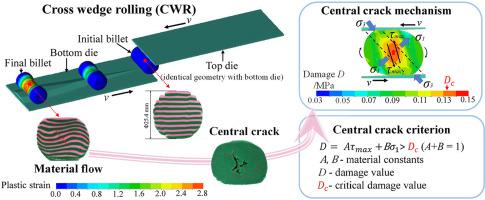International Journal of Machine Tools and Manufacture ( IF 14.0 ) Pub Date : 2020-10-29 , DOI: 10.1016/j.ijmachtools.2020.103647 Xianyan Zhou , Zhutao Shao , Chi Zhang , Fengzhen Sun , Wenbin Zhou , Lin Hua , Jun Jiang , Liliang Wang

|
Cross wedge rolling (CWR) is an innovative metal forming process to manufacture axisymmetric stepped shafts used in the transport industry. Central cracking, also called the Mannesmann Effect, consistently occurs in the central region of the CWR workpiece. This results in reduced product quality and increased costs due to rejected and failed parts. However, the understanding of central cracking mechanism and criterion is limited due to the complex stress states in CWR and the experimental limitations. A large number of CWR tests and different die geometries are required in the identification of the potential mechanistic factors such as the axial tensile stress, secondary tensile stress, shear stress and cyclic loading. Also, there is as yet no efficient method of determining the material constants associated with the central cracking fracture criteria. These problems are addressed in the present study. A physical model was built to reproduce the industrial CWR process. A newly designed model material (plasticine/flour composite) was used to mimic the material flows and internal fracture behaviours found in commercial CWR workpieces. This allowed a variety of die shapes to be rapidly and cost-effectively 3D printed, thereby enabling specific stress states to be achieved within the workpiece. Via experimental observations and the corresponding finite element modelling under different die geometries, the maximum shear stress was identified as the dominant factor for central cracking. The fracture criterion involving the maximum shear stress was quantitatively verified to be accurate and robust in predicting central cracking moments and locations. A novel approach using simplified die geometries to determine the associated material constants was proposed and validated. The high accuracy and cost/time efficiency of this new approach will be a significant benefit to fundamental research and also in industrial applications.
中文翻译:

楔横轧中心裂纹机理及判据的研究
楔横轧(CWR)是一种创新的金属成型工艺,用于制造运输行业中使用的轴对称阶梯轴。中央裂纹(也称为曼内斯曼效应)始终发生在CWR工件的中央区域。由于零件报废和故障,导致产品质量下降,成本增加。然而,由于CWR中复杂的应力状态和实验局限性,对中心开裂机理和判据的理解受到限制。在识别潜在的机械因素(例如轴向拉伸应力,二次拉伸应力,剪切应力和循环载荷)时,需要进行大量的CWR测试和不同的模具几何形状。也,尚没有确定与中心开裂断裂标准相关的材料常数的有效方法。这些问题在本研究中得到解决。建立了物理模型来重现工业CWR过程。一种新设计的模型材料(橡皮泥/面粉复合材料)用于模拟商用CWR工件中的材料流动和内部断裂行为。这样就可以快速且经济高效地3D打印各种模具形状,从而在工件内实现特定的应力状态。通过实验观察和在不同模具几何形状下的相应有限元建模,最大剪切应力被确定为中心裂纹的主导因素。定量验证了涉及最大剪切应力的断裂准则,该准则在预测中心裂纹时刻和位置方面是准确而稳健的。提出并验证了一种使用简化模具几何形状确定相关材料常数的新颖方法。这种新方法的高精度和成本/时间效率将对基础研究以及工业应用带来巨大的好处。











































 京公网安备 11010802027423号
京公网安备 11010802027423号